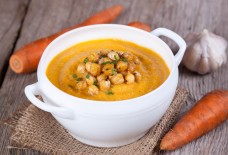Medium Rare Steak
Roasted Forest Mushrooms
Japanese Yams
Shirodashi-Miso Reduction
Dukkah Spice
5 Spice Blends from the Middle East to Enhance Your Dishes
SOURCE: KAWA
Why don’t you take a moment in the kitchen and travel to the far reaches of the Middle East? Between the freshness of the za’atar, the spiciness of the harissa and the aromatic power of the bezar, preparing and tasting good little dishes has never been so exotic. Here are 5 spice blends to discover.
1 – The Baharat
Both sweet and spicy, Baharat is a spice blend widely used in Lebanon, Syria, Iraq, Jordan and Palestine. While each region adds its own personal touch – such as saffron and black lemon dried in the Persian Gulf – the traditional blend consists of cumin, black pepper, caraway, cardamom, nutmeg, cloves, cinnamon, paprika, and chili pepper.
How to use it? The baharat is ideal to give pep to your winter soups, flavoring white meats, but also lamb and beef. It also enhances tomato sauce, fried vegetables, and fish dishes. A must-see!
2 – The dukkah
Native to Egypt, dukkah combines spices and dried fruits. As a result, it brings crunchiness to your preparations. Its composition? Hazelnuts, coriander seeds, sesame, cumin, black pepper, squash seeds, thyme and, depending on the recipe, paprika.
How to use it? Like the Egyptians, you can use dukkah as a breading for meat, fish, and eggs. The mixture can also be sprinkled on a fresh fruit salad or incorporated into your dressing.
3 – The za’atar
A flagship element of Levantine cuisine, za’atar has a green color due to its aromatic herbs: thyme and oregano. To these are added sesame seeds, dried sumac berries and sometimes marjoram.
How to use it? As in Lebanon, za’atar is sprinkled on bread dipped in olive oil, on grilled vegetables, hummus or baba ganoush. A good alternative to Provençal herbs!
4 – The harissa
Native to Tunisia, this red pepper puree has spread widely in the Middle East. While the traditional recipe uses olive oil and a pinch of salt, some regions add garlic, saffron, cumin or coriander seeds to this base. Harissa can be more or less spicy depending on the variety of chili peppers chosen.
How to use it? This condiment adds spice to couscous, fish, vegetables and many other dishes. As an aperitif, harissa can be eaten as a spread with tuna.
5 – The bezar
An aromatic blend typical of the United Arab Emirates, and more particularly of the city of Dubai, the bezar combines powerful fragrance and spicy notes. It is made from cumin, fennel, coriander, black pepper, turmeric, cayenne pepper, and cinnamon.
How to use it? Be inspired by the Emirati cuisine and perfume fish, shellfish and grilled meats with the bezar. A bouquet of spices to sprinkle on simmered dishes as well.





